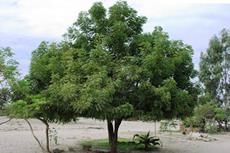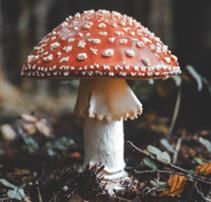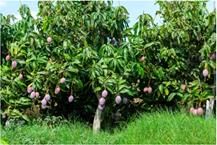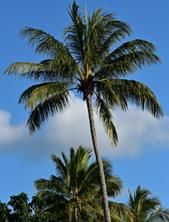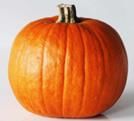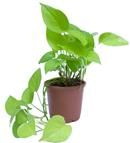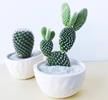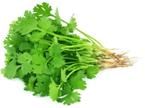All Exams >
Grade 2 >
Science for Grade 2 >
All Questions
All questions of Plants Around Us for Grade 2 Exam
Study the flow chart and choose the correct statement.
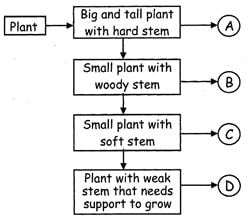
- a)A is a Rose plant
- b)B is a Hibiscus plant
- c)C is a Banyan tree
- d)D is a Shrub
Correct answer is option 'C'. Can you explain this answer?
Study the flow chart and choose the correct statement.


a)
A is a Rose plant
b)
B is a Hibiscus plant
c)
C is a Banyan tree
d)
D is a Shrub

|
Keystone Instructors answered |
- 'B' is a Hibiscus plant which is a small plant with woody stem.
Which of the following part is known as the food storehouse of the plant?- a)Stem
- b)Leaves
- c)Root
- d)Shoot
Correct answer is option 'A'. Can you explain this answer?
Which of the following part is known as the food storehouse of the plant?
a)
Stem
b)
Leaves
c)
Root
d)
Shoot
|
|
Pranav Singh answered |
Stem is the food storehouse of the plant.
What are the similarities between the plants bearing the flowers as shows?

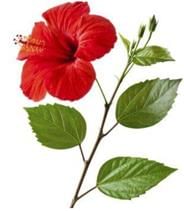
- a)They have weak stems
- b)They have woody stem
- c)They have very big leaves
- d)They grow along the ground
Correct answer is option 'B'. Can you explain this answer?
What are the similarities between the plants bearing the flowers as shows?




a)
They have weak stems
b)
They have woody stem
c)
They have very big leaves
d)
They grow along the ground
|
|
Pranav Singh answered |
- Rose and hibiscus plants have woody stem.
Direction: Select the odd one out- a)root
- b)shoot
- c)trees
- d)leaves
Correct answer is option 'C'. Can you explain this answer?
Direction: Select the odd one out
a)
root
b)
shoot
c)
trees
d)
leaves
|
|
Pranav Singh answered |
Root, shoot and leaves are the part of plant, tree is a type of plants.
Which is these is obtained from plants?- a)Paper
- b)Animals
- c)Medicine
- d)Both (a) and (b)
Correct answer is option 'D'. Can you explain this answer?
Which is these is obtained from plants?
a)
Paper
b)
Animals
c)
Medicine
d)
Both (a) and (b)
|
|
Pranav Singh answered |
Both paper and medicines are obtained from plants.
Fruits develop from __________.- a)leaves
- b)flowers
- c)seeds
- d)stem
Correct answer is option 'B'. Can you explain this answer?
Fruits develop from __________.
a)
leaves
b)
flowers
c)
seeds
d)
stem
|
|
Pranav Singh answered |
Fruits develop from flower.
Which of these is an important function of the roots of a plant?- a)To absorb oxygen from the atmosphere
- b)To absorb carbon dioxide from the atmosphere
- c)To absorb water and minerals from the soil
- d)All of these
Correct answer is option 'C'. Can you explain this answer?
Which of these is an important function of the roots of a plant?
a)
To absorb oxygen from the atmosphere
b)
To absorb carbon dioxide from the atmosphere
c)
To absorb water and minerals from the soil
d)
All of these
|
|
Pranav Singh answered |
- Roots absorb water and minerals from the soil.
Direction: Select the odd one out- a)cactus
- b)rose
- c)cotton
- d)hibiscus
Correct answer is option 'A'. Can you explain this answer?
Direction: Select the odd one out
a)
cactus
b)
rose
c)
cotton
d)
hibiscus
|
|
Pranav Singh answered |
Rose, cotton and hibiscus are shrubs, cactus is a desert plant.
Oil is not abstained from which of the following plant?- a)Mango plant
- b)Sunflower plant
- c)Mustard plant
- d)Coconut plant
Correct answer is option 'A'. Can you explain this answer?
Oil is not abstained from which of the following plant?
a)
Mango plant
b)
Sunflower plant
c)
Mustard plant
d)
Coconut plant
|
|
Prateek Saini answered |
Answer:
Introduction:
In this question, we are asked to identify the plant from which oil is not abstained. We are given four options: Mango plant, Sunflower plant, Mustard plant, and Coconut plant. We need to determine which plant does not produce oil.
Explanation:
Let's analyze each option one by one:
a) Mango plant:
Mango plants do not produce oil. The fruit of the mango plant contains a single large seed, called the mango kernel or mango stone. However, this kernel does not yield oil. Mangoes are primarily consumed as a fruit and are known for their delicious taste.
b) Sunflower plant:
Sunflower plants are one of the major sources of edible oil. The seeds of the sunflower plant are highly prized for their oil content. Sunflower oil is commonly used for cooking purposes and is known for its light flavor and high smoking point.
c) Mustard plant:
Mustard plants produce oil that is commonly known as mustard oil. The seeds of the mustard plant are crushed or pressed to extract the oil. Mustard oil is widely used in cooking, particularly in Indian and Asian cuisines. It has a strong flavor and is often used for its distinctive taste and aroma.
d) Coconut plant:
Coconut plants are another significant source of oil. The coconut itself is a fruit, and the oil is extracted from the copra, which is the dried kernel of the coconut. Coconut oil is widely used for cooking, as well as for various other purposes such as skin and hair care.
Conclusion:
After analyzing all the options, we can conclude that the plant from which oil is not abstained is the Mango plant. While sunflower, mustard, and coconut plants all produce oil, the mango plant does not yield oil.
Introduction:
In this question, we are asked to identify the plant from which oil is not abstained. We are given four options: Mango plant, Sunflower plant, Mustard plant, and Coconut plant. We need to determine which plant does not produce oil.
Explanation:
Let's analyze each option one by one:
a) Mango plant:
Mango plants do not produce oil. The fruit of the mango plant contains a single large seed, called the mango kernel or mango stone. However, this kernel does not yield oil. Mangoes are primarily consumed as a fruit and are known for their delicious taste.
b) Sunflower plant:
Sunflower plants are one of the major sources of edible oil. The seeds of the sunflower plant are highly prized for their oil content. Sunflower oil is commonly used for cooking purposes and is known for its light flavor and high smoking point.
c) Mustard plant:
Mustard plants produce oil that is commonly known as mustard oil. The seeds of the mustard plant are crushed or pressed to extract the oil. Mustard oil is widely used in cooking, particularly in Indian and Asian cuisines. It has a strong flavor and is often used for its distinctive taste and aroma.
d) Coconut plant:
Coconut plants are another significant source of oil. The coconut itself is a fruit, and the oil is extracted from the copra, which is the dried kernel of the coconut. Coconut oil is widely used for cooking, as well as for various other purposes such as skin and hair care.
Conclusion:
After analyzing all the options, we can conclude that the plant from which oil is not abstained is the Mango plant. While sunflower, mustard, and coconut plants all produce oil, the mango plant does not yield oil.
The leaves of ___________ are used as food.- a)anion
- b)cabbage
- c)eggs
- d)ginger
Correct answer is option 'B'. Can you explain this answer?
The leaves of ___________ are used as food.
a)
anion
b)
cabbage
c)
eggs
d)
ginger
|
|
Pranav Singh answered |
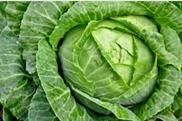
- The leaves of cabbage are used as food.
What is the lifespan range of plants?- a) A few years to several decades
- b) Only a few months
- c) Only a few days
- d) A few months to many years
Correct answer is option 'D'. Can you explain this answer?
What is the lifespan range of plants?
a)
A few years to several decades
b)
Only a few months
c)
Only a few days
d)
A few months to many years

|
Bespoke Classes answered |
Plants can have a lifespan ranging from a few months to many years, depending on their type. For example, herbs may live for only a few months, while trees can live for hundreds or even thousands of years. This diversity in lifespans reflects the adaptability of plants to different environments and ecological niches.
How do green plants primarily make their food?- a) By storing energy in fruits
- b) By consuming other plants
- c) Through photosynthesis using sunlight
- d) By absorbing nutrients from the soil
Correct answer is option 'C'. Can you explain this answer?
How do green plants primarily make their food?
a)
By storing energy in fruits
b)
By consuming other plants
c)
Through photosynthesis using sunlight
d)
By absorbing nutrients from the soil

|
Bespoke Classes answered |
Green plants create their food through the process of photosynthesis, where they convert sunlight, water, and carbon dioxide into glucose and oxygen. This process is fundamental to life on Earth, as it is the primary source of energy for almost all living organisms.
Which type of plant is typically smaller than trees and is often referred to as bushes?- a) Climber
- b) Shrub
- c) Creeper
- d) Herb
Correct answer is option 'B'. Can you explain this answer?
Which type of plant is typically smaller than trees and is often referred to as bushes?
a)
Climber
b)
Shrub
c)
Creeper
d)
Herb

|
Bespoke Classes answered |
Shrubs are indeed smaller than trees and are often referred to as bushes. They usually have multiple thin stems and can provide habitat for various wildlife. An interesting fact about shrubs is that they often play a key role in landscaping and gardening due to their versatile sizes and shapes.
Direction: Select the odd one out- a)money plant
- b)grapevine
- c)bean
- d)pumpkin
Correct answer is option 'D'. Can you explain this answer?
Direction: Select the odd one out
a)
money plant
b)
grapevine
c)
bean
d)
pumpkin

|
Kds Coaching answered |
Money plant, grapevine, and bean are all climbers—plants that need support to grow upward. Pumpkin is a creeper, which means it spreads along the ground and does not climb upward. Therefore, the odd one out is pumpkin.
What are the colorful parts of a plant that produce fruits or seeds called?- a) Roots
- b) Leaves
- c) Flowers
- d) Stems
Correct answer is option 'C'. Can you explain this answer?
What are the colorful parts of a plant that produce fruits or seeds called?
a)
Roots
b)
Leaves
c)
Flowers
d)
Stems

|
Bespoke Classes answered |
Flowers are indeed the colorful reproductive structures of plants, responsible for producing fruits and seeds. They attract pollinators such as bees and butterflies, which play a crucial role in the reproduction of many plants. Interestingly, the diversity of flower colors and shapes is a result of evolutionary adaptations to attract specific pollinators.
Which plants are known to grow in water?- a) Trees
- b) Shrubs
- c) Herbs
- d) Water Plants
Correct answer is option 'D'. Can you explain this answer?
Which plants are known to grow in water?
a)
Trees
b)
Shrubs
c)
Herbs
d)
Water Plants

|
Bespoke Classes answered |
Water plants, such as lotus and water hyacinth, thrive in aquatic environments. These plants have adaptations that allow them to survive in water, such as buoyant leaves and specialized roots. They play a vital role in aquatic ecosystems by providing oxygen and habitat for various aquatic species.
Which plant type grows along the ground and has weak stems?- a) Tree
- b) Herb
- c) Climber
- d) Creeper
Correct answer is option 'D'. Can you explain this answer?
Which plant type grows along the ground and has weak stems?
a)
Tree
b)
Herb
c)
Climber
d)
Creeper

|
Bespoke Classes answered |
Creepers are plants that grow along the ground due to their weak stems. They often produce larger fruits compared to other plants. A fascinating fact is that many creepers, such as pumpkins and cucumbers, can cover substantial areas, making them excellent for ground cover in gardens.
Which of the following plants is an example of a creeper?- a) Neem
- b) Rose
- c) Bottle gourd
- d) Pea plant
Correct answer is option 'C'. Can you explain this answer?
Which of the following plants is an example of a creeper?
a)
Neem
b)
Rose
c)
Bottle gourd
d)
Pea plant

|
Bespoke Classes answered |
Bottle gourd is a classic example of a creeper, characterized by its growth along the ground. Creepers often produce larger fruits and can spread extensively across the ground, providing cover and preventing soil erosion in many cases.
Direction: Select the odd one out- a)table
- b)chair
- c)door
- d)medicine
Correct answer is option 'D'. Can you explain this answer?
Direction: Select the odd one out
a)
table
b)
chair
c)
door
d)
medicine
|
|
Pranav Singh answered |
Table, chair and doors are obtained from wood.
Which part of the plant is primarily responsible for supporting it and carrying nutrients?- a) Leaves
- b) Stem
- c) Roots
- d) Flowers
Correct answer is option 'B'. Can you explain this answer?
Which part of the plant is primarily responsible for supporting it and carrying nutrients?
a)
Leaves
b)
Stem
c)
Roots
d)
Flowers

|
Bespoke Classes answered |
The stem plays a crucial role in supporting the plant and transporting nutrients and water from the roots to the leaves and flowers. Its structure allows the plant to grow tall, maximizing access to sunlight, which is essential for photosynthesis.
Which plant type typically lives for only a few months?- a) Herb
- b) Tree
- c) Climber
- d) Shrub
Correct answer is option 'A'. Can you explain this answer?
Which plant type typically lives for only a few months?
a)
Herb
b)
Tree
c)
Climber
d)
Shrub

|
Bespoke Classes answered |
Herbs generally have shorter lifespans, typically living for only a few months. This quick growth cycle allows them to thrive in various environments and makes them ideal for gardens and culinary uses. Many herbs are also known for their medicinal properties and are harvested regularly.
What type of plant is characterized by having a thick, brown, woody stem and can live for many years?- a) Tree
- b) Shrub
- c) Climber
- d) Herb
Correct answer is option 'A'. Can you explain this answer?
What type of plant is characterized by having a thick, brown, woody stem and can live for many years?
a)
Tree
b)
Shrub
c)
Climber
d)
Herb

|
Bespoke Classes answered |
Trees are significant as they can grow tall and strong, with a structure that supports their longevity. They have a thick trunk, which allows them to withstand environmental challenges. Interestingly, some tree species can live for over a thousand years, making them some of the oldest living organisms on Earth.
Small plants with weak stems are called herbs. Which of the these is a herb?- a)Tulsi
- b)Apple
- c)Gulmohar
- d)Grapevine
Correct answer is option 'A'. Can you explain this answer?
Small plants with weak stems are called herbs. Which of the these is a herb?
a)
Tulsi
b)
Apple
c)
Gulmohar
d)
Grapevine

|
Kds Coaching answered |
- Tulsi, also known as holy basil, is a small plant with a soft stem, making it a herb.
- Herbs are typically characterized by their aromatic properties and are often used in cooking or for medicinal purposes.
- In contrast, apple, gulmohar, and grapevine are larger plants or trees, classified as shrubs or woody plants.
What part of the plant is primarily responsible for making food?- a) Flowers
- b) Stem
- c) Leaves
- d) Roots
Correct answer is option 'C'. Can you explain this answer?
What part of the plant is primarily responsible for making food?
a)
Flowers
b)
Stem
c)
Leaves
d)
Roots

|
Bespoke Classes answered |
Leaves are known as the "kitchen" of the plant because they conduct photosynthesis, using sunlight, water, and carbon dioxide to produce food. This process not only sustains the plant but also contributes to the oxygen supply in the atmosphere, highlighting the importance of plants in our ecosystem.
Which part of the plant grows from the flower and contains seeds?- a) Root
- b) Fruit
- c) Stem
- d) Leaf
Correct answer is option 'B'. Can you explain this answer?
Which part of the plant grows from the flower and contains seeds?
a)
Root
b)
Fruit
c)
Stem
d)
Leaf

|
Bespoke Classes answered |
Fruits develop from flowers and contain seeds, serving as a mechanism for plant reproduction. They often play a crucial role in the dispersal of seeds, as animals eat the fruit and excrete the seeds elsewhere. This relationship illustrates the interconnectedness of plants and animals in ecosystems.
Which of the following is NOT a characteristic of climbers?- a)They have weak stems.
- b)They need water to grow
- c)They can grow upright without support.
- d)They usually have flowers or fruits.
Correct answer is option 'C'. Can you explain this answer?
Which of the following is NOT a characteristic of climbers?
a)
They have weak stems.
b)
They need water to grow
c)
They can grow upright without support.
d)
They usually have flowers or fruits.

|
Bespoke Classes answered |
Climbers cannot grow upright without support; they rely on other structures to establish their growth. This characteristic allows them to reach sunlight and expand their growth area. Many climbers, like the money plant, can rapidly cover large areas when given adequate support.
What do the rings in a tree's trunk indicate?- a) The amount of fruit produced
- b) The age of the tree
- c) The type of tree
- d) The health of the tree
Correct answer is option 'B'. Can you explain this answer?
What do the rings in a tree's trunk indicate?
a)
The amount of fruit produced
b)
The age of the tree
c)
The type of tree
d)
The health of the tree

|
Bespoke Classes answered |
The rings within a tree's trunk represent its age, as each ring corresponds to a year of growth. By counting these rings, one can determine how long a tree has been alive. Interestingly, the width of the rings can also indicate the environmental conditions during each growth year, such as droughts or abundant rainfall.
What is the main function of the plant's stem?- a) To support the plant
- b) To absorb water
- c) To store nutrients
- d) To produce food
Correct answer is option 'A'. Can you explain this answer?
What is the main function of the plant's stem?
a)
To support the plant
b)
To absorb water
c)
To store nutrients
d)
To produce food

|
Bespoke Classes answered |
The stem serves as the main body of the plant, providing structural support for leaves, branches, and flowers. It also facilitates the transport of water and nutrients between roots and other parts of the plant. Interestingly, some plants have adapted their stems to store water, like succulents, which allows them to thrive in arid environments.
Study the given figure. Which of the following best represents X and Y?

- a)X---- Mustard, Y ---- Sunflower
- b)X---- Coconut, Y ----- Sunflower
- c)X---- Sunflower, Y ----- Groundnut
- d)X---- Groundunt, Y ----- Mustard
Correct answer is option 'B'. Can you explain this answer?
Study the given figure. Which of the following best represents X and Y?


a)
X---- Mustard, Y ---- Sunflower
b)
X---- Coconut, Y ----- Sunflower
c)
X---- Sunflower, Y ----- Groundnut
d)
X---- Groundunt, Y ----- Mustard

|
Tutorpedia Coaching answered |
X-Coconut, Y-Sunflower.
What is the primary role of leaves in a plant?- a) To make food
- b) To store water
- c) To produce seeds
- d) To anchor the plant
Correct answer is option 'A'. Can you explain this answer?
What is the primary role of leaves in a plant?
a)
To make food
b)
To store water
c)
To produce seeds
d)
To anchor the plant

|
Bespoke Classes answered |
The primary function of leaves is to make food for the plant through photosynthesis. This process is vital not just for the plant's survival but also for the ecosystem, as it produces oxygen and serves as the base of the food chain for many organisms.
Which type of plant has thin, green, and soft stems?- a) Tree
- b) Shrub
- c) Creeper
- d) Herb
Correct answer is option 'D'. Can you explain this answer?
Which type of plant has thin, green, and soft stems?
a)
Tree
b)
Shrub
c)
Creeper
d)
Herb

|
Bespoke Classes answered |
Herbs are characterized by their thin, green, and soft stems. This structure allows them to grow quickly and easily reproduce. Many herbs are also cultivated for culinary purposes, adding flavor and nutrition to our meals, showcasing their importance in our diets.
What do roots primarily do for a plant?- a)Collect water and minerals
- b)Support the plant
- c)Produce food
- d)Store energy
Correct answer is option 'A'. Can you explain this answer?
What do roots primarily do for a plant?
a)
Collect water and minerals
b)
Support the plant
c)
Produce food
d)
Store energy

|
Bespoke Classes answered |
Roots are essential for collecting water and minerals from the soil, which are vital for the plant's growth. They also anchor the plant firmly in the ground, preventing it from being uprooted by wind or water. An interesting aspect of roots is that they can also store energy in the form of carbohydrates, supporting the plant during periods of dormancy.
Which type of plant has weak stems and requires support to grow?- a) Herb
- b) Tree
- c) Water Plant
- d) Climber
Correct answer is option 'D'. Can you explain this answer?
Which type of plant has weak stems and requires support to grow?
a)
Herb
b)
Tree
c)
Water Plant
d)
Climber

|
Bespoke Classes answered |
Climbers have weak stems that cannot stand alone and rely on other structures for support. They often showcase beautiful flowers or fruits and can create lush green coverage in gardens. Interestingly, many climbers can adapt to various environments, from garden trellises to wild forests.
Which of the following plants is an example of a herb?- a) Banyan
- b) Mint
- c) Hibiscus
- d) Coconut
Correct answer is option 'B'. Can you explain this answer?
Which of the following plants is an example of a herb?
a)
Banyan
b)
Mint
c)
Hibiscus
d)
Coconut

|
Bespoke Classes answered |
Mint is a classic example of a herb, characterized by its small size and soft, green stems. Herbs are often used in cooking for their flavor and aroma, and they can also have medicinal properties. In fact, many herbs, like mint, are known for their refreshing qualities and are used in various cuisines worldwide.
Chapter doubts & questions for Plants Around Us - Science for Grade 2 2025 is part of Grade 2 exam preparation. The chapters have been prepared according to the Grade 2 exam syllabus. The Chapter doubts & questions, notes, tests & MCQs are made for Grade 2 2025 Exam. Find important definitions, questions, notes, meanings, examples, exercises, MCQs and online tests here.
Chapter doubts & questions of Plants Around Us - Science for Grade 2 in English & Hindi are available as part of Grade 2 exam.
Download more important topics, notes, lectures and mock test series for Grade 2 Exam by signing up for free.
Science for Grade 2
16 videos|81 docs|26 tests
|

Contact Support
Our team is online on weekdays between 10 AM - 7 PM
Typical reply within 3 hours
|
Free Exam Preparation
at your Fingertips!
Access Free Study Material - Test Series, Structured Courses, Free Videos & Study Notes and Prepare for Your Exam With Ease

 Join the 10M+ students on EduRev
Join the 10M+ students on EduRev
|

|
Create your account for free
OR
Forgot Password
OR
Signup to see your scores
go up within 7 days!
Access 1000+ FREE Docs, Videos and Tests
Takes less than 10 seconds to signup

